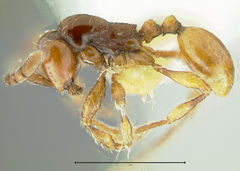Key to Aenictus of India
This key to workers of Indian Aenictus is based on Bharti et al. (2012) as modified by Sahoo et al. (2023).
Note that this key does not include Aenictus kodungallurensis or Aenictus malakkaparensis, both of which were described after Bharti et al.'s key was published.
1
- Mandibles narrow, 3- or 4-toothed, and in closed position their inner borders are often (but not always) separated from the anterior clypeal border by a large gap => 2
- Mandibles broad and triangular; bearing a distinct apical tooth and a preapical tooth, followed by at least 4 or 5 smaller teeth or denticles, the posteriormost of which are much smaller than the apical tooth; mandibular gap lacking => 5
2
return to couplet #1
- Anterior clypeal border entire and convex and bearing approximately 6 small but distinct teeth; a small (HW, 0.51–0.53 mm), shining, very hairy brownish yellow species with very short scapes (SI, 66–69) => Aenictus brevicornis
- Anterior clypeal border lacking teeth, and emarginate => 3
3
return to couplet #2
- Scapes very short (SI, 58–61); junction of propodeal faces an even convex curve => 4
- Scapes longer (SI of at least 70); junction of propodeal faces angulate => Aenictus ceylonicus
4
return to couplet #3
- Clypeus strongly emarginate; mandibles thick, strongly curved inward; at closure the inner mandibular borders are separated from the anterior clypeal border by a gap as wide as the maximum width of the scape => Aenictus doryloides
- Clypeus straight or slightly convex; mandibles neither conspicuously thickened or curved inward; in closure the inner mandibular borders either reach the anterior clypeal border or are separated from it by a gap much narrower than in doryloides => Aenictus piercei
5
return to couplet #1
- “Typhlatta spots” present; these are a pair of large, pale, circular areas covering most of the posterolateral portions of the head and contrasting sharply with the much darker remainder of the head => 6
- “Typhlatta spots” absent => 9
6
return to couplet #5
- Subpetiolar process prominent and angular => 7
- Subpetiolar process absent or at most very low and rounded => Aenictus gracilis
7
return to couplet #6
- Seen from the side, the propodeal faces join through a smooth curve => Aenictus laeviceps
- Seen from the side, the propodeal faces join in a sharp angle => 8
8
return to couplet #7
- Pronotal dorsum microreticulate and opaque; a somewhat larger species, HW, 0.79–0.92 mm => Aenictus binghamii
- Pronotal dorsum smooth and shining; HW, 0.63–0.78 mm => Aenictus fergusoni
9
return to couplet #5
- Subpetiolar process large and angulate => 10
- Subpetiolar process either absent or else merely a low, evenly round lobe => 11
10
return to couplet #9
- Whole mesosoma opaque and sculuptured, mandibles with 5 indistinct denticles => Aenictus shillongensis
- Pronotum shining, remainder of mesosoma and petiole microreticulate; mandibles with more than 5 denticles => Aenictus peguensis
11
return to couplet #9
- Mesonotum demarcated from mesopleuron by a conspicuous ridge => 12
- Mesonotum not visibly demarcated from mesopleuron => 13
12
return to couplet #11
- Reddish brown; head width 0.84 mm; metanotal impression present; parafrontal ridge about 0.22mm long => Aenictus indicus
- Blackish; head width 0.7–0.74 mm; metanotal impression absent; parafrontal ridge about 0.27 mm long => Aenictus wilsoni
13
return to couplet #11
- Anterior clypeal border dentate; small species, HW 0.43-0.53 mm; scapes long, scape index at least 102 and usually much more => 14
- Anterior clypeal border not dentate; larger species, HW at least 0.57 mm; scapes shorter, scape index not exceeding 102 and usually much less => 15
14
return to couplet #13
- Head width 0.43–0.44 mm; scape index 116–119 => Aenictus wroughtonii
- Head width 0.46–0.53 mm; scape index 102–108 => Aenictus sagei
15
return to couplet #13
- Occiput constricted behind into narrow but distinct “collar”; propodeal angle (junction of basal and declivitous faces) longer in profile than maximum length of propodeal spiracle, very thin acute, and far overhanging the declivitous face; a large species (HW, 0.78–0.81 mm) with long (SI about 137) => Aenictus dentatus
- Occiput not constricted behind into a large collar; propodeal angle no longer than maximum spiracle width and not overhanging the declivitous face => 16
16
return to couplet #15
- Pronotum densely microreticulate and opaque => Aenictus aitkenii
- Pronotum mostly smooth and shining => 17
17
return to couplet #16
- Longitudinal rugulae present on propodeal dorsum; head shining except for microreticulate band of occiput => Aenictus punensis
- Longitudinal rugulae lacking on propodeal dorsum; head partly shiny or completely microreticulate => 18
18
- Head opaque and everywhere microreticulate => Aenictus pachycerus
- Head smooth and shining except the area close to parafrontal ridges => Aenictus kadalarensis
References
- Bharti, H.; Wachkoo, A. A.; Kumar, R. 2012. Two remarkable new species of Aenictus (Hymenoptera: Formicidae) from India. Journal of Asia-Pacific Entomology 15:291-294.
- Sahoo, B., Ramakrishnaiah, S., Rajan, P.D., Datta-Roy, A. 2023. A new species of army ant genus Aenictus (Hymenoptera: Formicidae) from India. Journal of the Entomological Research Society 25(3), 615-622 (doi:10.51963/jers.v25i3.2504).


































